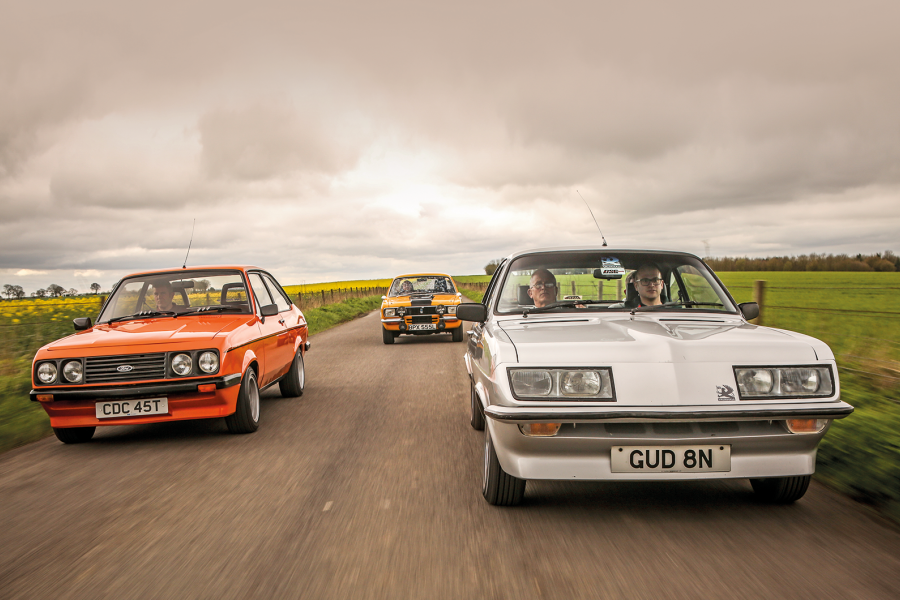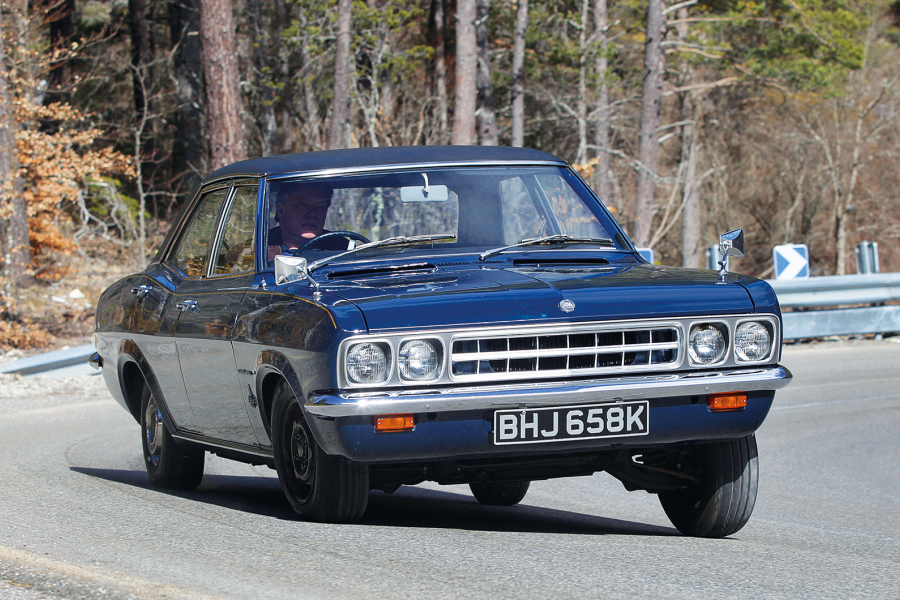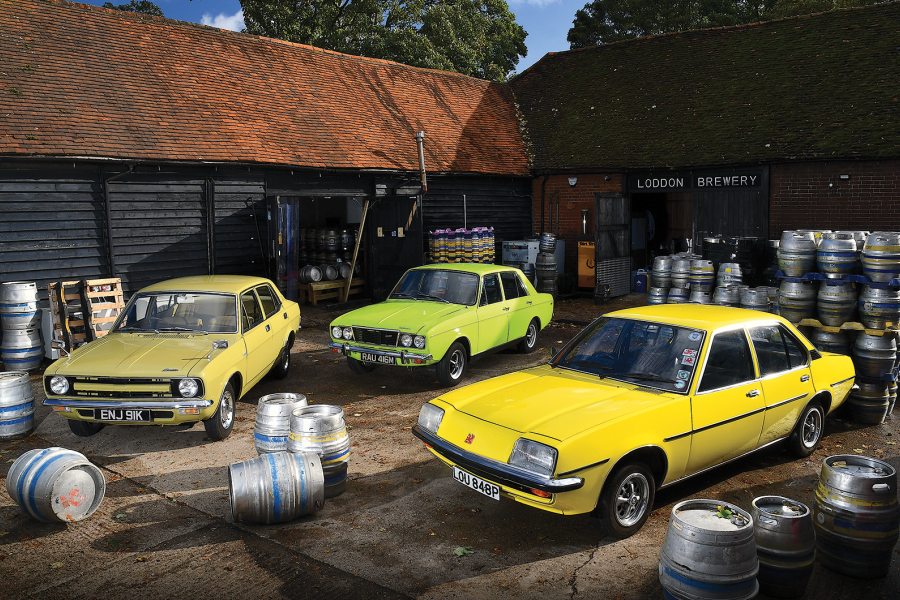I’m not going to contemplate what would happen if one of them was to let go…
The KRIT 100hp Aero feels mighty to drive
Compared to the Viper, there’s not even a vestige of bodywork to retain you once you’re sitting aloft in the driver’s seat.
Instrumentation across the wooden bulkhead is sparse, the most prominent being for revs – redlined at 1500rpm – supplemented by two more for air and oil pressure.
Above them all is KRIT’s trademark swastika logo, which had nothing to do with the later Nazi party and was, in reality, a long-held symbol of good fortune in the USA, way before it acquired its more sinister connotations.
With fuel-tank pressure pumped up to 2psi, taps on and carburettor flooded, the KRIT starts with a flick of the magneto switch.
The KRIT 100hp Aero racer’s simple dashboard
With only stub-exhausts jutting from the top of each cylinder, the aural assault is instant – and glorious.
It erupts into a bassy staccato beat that hurts your ears, but induces wide grins among everyone standing in the vicinity.
As with the Vauxhall, you engage first in a reversed H-pattern (to the right and up) on your right.
There’s a centre throttle again, but this time braking is by the right-hand pedal, with the hand lever used only as a parking brake.
‘A new type of devil-may-care merchant surfaced post-war: fearless fighter pilots seeking a dogfight-equalling adrenalin rush’
Accelerate away and the KRIT is by far the most user-friendly.
You change up early, but at higher revs than in the Vauxhall, meaning that for most of this short circuit you stay in third, revelling at the relative balance and composure into and out of bends.
It takes a while to shake the perception that this ancient behemoth is going to chuck you into the greenery if you push a bit too hard, but its set-up inspires such confidence that you find yourself going faster than seems prudent after just a lap or two.
This once-famous name has links with Fiat
All of this leaves the SCAT as the only one of our Edwardians to have been a racer from new. Well, almost.
Andrew Howe-Davies’ Type C is actually a painstaking recreation of the car that, in 1911, gave SCAT the first of its three pre-WW1 Targa Florio victories.
SCAT (Società Ceirano Automobili Torino) was established by Giovanni Battista Ceirano in 1906, but, with his brother Matteo, Giovanni had already laid the foundations for Italy’s automotive industry when he sold the patent to his Welleyes motor car to one Giovanni Agnelli in 1899.
Fantastic patina on the SCAT Type C racer
SCAT’s inaugural Targa entry would have been an important promotional lever for the young company.
But to compete with the likes of Mercedes, Lancia and ALFA, SCAT’s 22/32 chassis needed more firepower than offered by its existing 4.4-litre monobloc motor.
The solution came in the form of a Smith & Mabley-designed 9230cc T-head ‘four’, manufactured by the Simplex Automobile Co in New York.
The SCAT Type C’s big ‘four’ is the only unit here originally bound for a car rather than a plane
The production unit used a gravity oil feed to lubricate its crankshaft’s three main bearings.
But Targa scrutineers would have taken a dim view of what was in effect a total-loss oil system on a racing car, so SCAT equipped the engine with a camshaft-driven pump that scavenged the oil from its pipes, returning it to a 2-litre catch-tank from which the mains could be fed.
Making 100bhp, the unit employed an early crossflow-type cylinder head, with intake and exhaust valves on opposing sides of the block, and updraught carburetion from a single Zenith SS.
A 1908 Darracq four-speed ’box (now uprated with a 1950s clutch to deal with the torque) transmitted drive to the rear axle.
The SCAT leads this pre-war pack around Mallory Park
Andrew’s car is faithful to that 1911 winner, in which Ceirano’s brother Ernesto completed three laps of the Sicilian road course in 9 hrs, 32 mins and 22 secs, averaging 29.08mph.
Not only does it use period running gear, but also an original SCAT 22/32 chassis and axles, all of which were discovered as a collection of parts in Australia in the ’80s.
In Andrew’s ownership since 2007, the car is a VSCC and Goodwood regular, and has won the Pomeroy Edwardian Trophy, the Sam Clutton Memorial Trophy at Prescott and the Dick Baddiley Trophy here at Mallory.
Like Tony, Andrew has also used the SCAT for various long-haul European schleps.
The SCAT Type C racing car’s wicker-backed chairs don’t offer vast amounts of support
The word ‘patina’ could have been coined for this car, its battle-scarred bodywork making it appear heroic, purposeful and somehow stoic.
As with the others, you climb up on the passenger side and drop into a comfy, wicker-backed seat.
Standing out amid countless scrutineering tags across the bulkhead is a rev counter marked in 200rpm increments to 1000rpm.
To your right is a conventional H-pattern gearshift, at your feet a three-pedal layout with the throttle in the ‘normal’ position.
The SCAT Type C racing car feels the lightest on track, but with the most play in the helm
Fuel and ignition on, flood the carb, press the starter then, once the huge ‘four’ catches, flick on the magneto.
On the move, the SCAT is the lightest to handle, though with more play in the steering.
I’ve never driven such a low-revving vehicle and, other than struggling slightly with the gearshift (entirely down to the user), the SCAT thumps around our stand-in Targa Florio course at remarkable pace, seemingly with its engine turning at little above an idle.
There really is no better illustration of early motoring’s pioneering spirit than this trio.
That they still thrill on road and track after more than a century is a blessing that should be bottled for future generations.
Images: John Bradshaw
Thanks to: Mallory Park Racing Circuit
Factfiles
Vauxhall Viper Aero
- Sold/number built 1913 (chassis)/one
- Construction pressed-steel chassis, aluminium and timber body
- Engine all-alloy with steel cylinder liners, sohc-per-bank 11,776cc V8, twin SU carburettors, dual magneto ignition
- Max power 200bhp (rated)
- Max torque 720lb ft @ 1250rpm
- Transmission four-speed manual, RWD
- Suspension semi-elliptic springs f/r
- Steering worm and wheel
- Brakes 16in rear drums, hand-lever operated
- Length 13ft 5in (4100mm)
- Width 5ft 6in (1700mm)
- Height 4ft 11in (1500mm)
- Wheelbase 10ft 5in (3050mm)
- Weight 2756lb (1250kg)
- Mpg 8
- 0-60mph n/a
- Top speed 116mph
- Price new n/a
- Price now n/a
KRIT 100hp Aero racer
- Sold/number built 1911 (chassis)/one
- Construction pressed-steel chassis, steel body
- Engine all-alloy with cast-iron barrels, ohv 9299cc 90° V8, single Zenith 06DS carburettor, dual magneto ignition
- Max power 100bhp
- Max torque 400lb ft (est)
- Transmission four-speed manual transaxle with chain drive, RWD
- Suspension: front three-quarter-elliptic springs rear semi-elliptic springs
- Steering worm and wheel
- Brakes 12in rear drums
- Length 12ft 3in (3733mm)
- Width 5ft (1524mm)
- Height 4ft (1219mm)
- Wheelbase 9ft (2743mm)
- Weight 2204lb (1000kg) (est)
- Mpg 10-12
- 0-60mph n/a
- Top speed 100mph (est)
- Price new n/a
- Price now £250-300,000*
SCAT Type C racer
- Sold/number built 1911/one
- Construction pressed-steel chassis, aluminium and timber body
- Engine all-iron, ‘T-head’ 9230cc ‘four’, single Zenith SS updraught carburettor, dual magneto ignition
- Max power 100bhp
- Max torque n/a
- Transmission four-speed manual, RWD
- Suspension semi-elliptic springs f/r
- Steering worm and wheel
- Brakes rear drums
- Length 13ft 11in (3980mm)
- Width n/a
- Height n/a
- Wheelbase 10ft 3in (3125mm)
- Weight 2645lb (1200kg) (est)
- Mpg 10-20
- 0-60mph n/a
- Top speed 100mph+ (est)
- Price new n/a
- Price now £250,000*
*Prices correct at date of original publication
Enjoy more of the world’s best classic car content every month when you subscribe to C&SC – get our latest deals here
READ MORE
Vauxhall 30-98 Wensum: The Yellow Peril
Genevieve reunion: meet the Darracq and Spyker film stars
Bentley Super Sports: vintage hooligan
Simon Hucknall
Simon Hucknall is a senior contributor to Classic & Sports Car






























